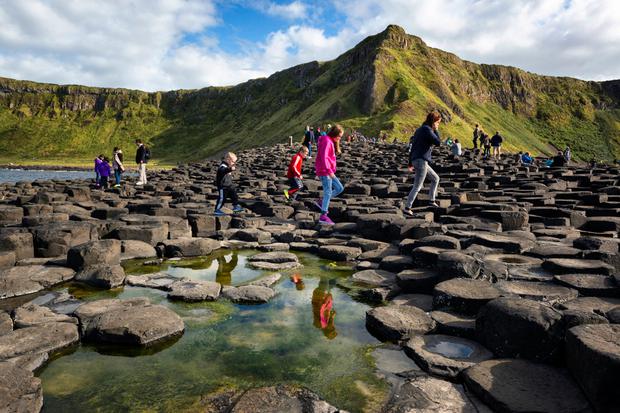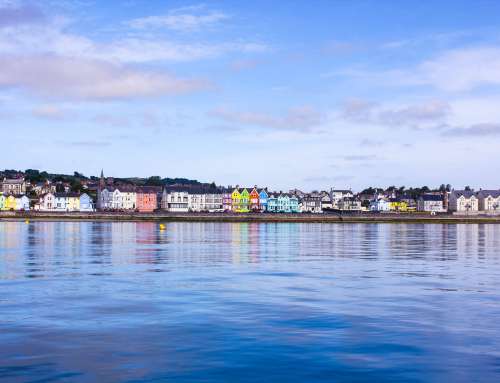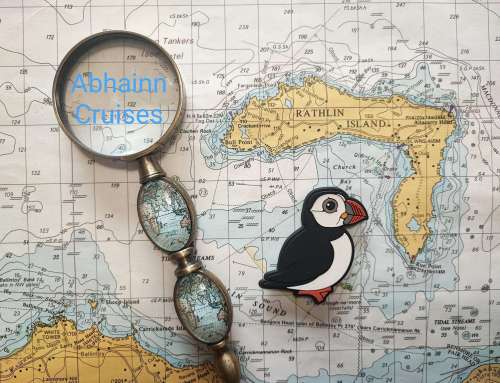Vacation to the island of Ireland from the United States
So you’re coming to Ireland, whether it’s a vacation with family or friends, a romantic getaway, part of a business expedition or an adventure as a solo traveller, here are some tips that may be useful.
- Being a tourist
I hear so many people say they don’t want to appear to be a tourist and that they don’t think they should go to the ‘touristy’ sites. But, hear me out, it’s ok to be a tourist and to appear as one. Ireland ‘is’ the land of a thousand welcomes and visitors are appreciated. We love the opportunity to help and guide your stay here so don’t be shy about asking for help, directions and advice from anyone you come across.
Visit the iconic sites. They are busy with tourists but there’s a good reason why. The Cliffs of Moher and Slieve League are breath-taking. The Giants Causeway is stunning. Carrick-a-Rede Rope Bridge is adventurous and scenic, our castles are steeped in history and distillery tours are a must for any Irish Whiskey or Gin lover. You won’t just find other international tourists at these sites, you’ll find local people too because we believe in exploring our own island and appreciate its history and beauty.
Talk to locals and find the hidden gems off the beaten track. You wouldn’t believe the places that are practically secrets; areas of profound natural beauty, islands in the middle of Lough Neagh, opportunities to experience heritage activities first hand like foraging in forests or on shorelines. So be a tourist. It doesn’t mean that you will be excluded from an authentic Irish experience at all. Just be open to having random chats with strangers and flexible plans and you’ll fit right in. Speaking of flexible plans…
- Suit yourself
Take time to think about the pace and plan that will suit you and your group. For some it’s a rigid itinerary with boxes to tick, a route to complete and a fast pace. If this is what you’re planning make sure it will suit everyone in your group and give yourself a fair bit of leeway. Ireland is not fast paced and she will not hurry along with you. The sheep will make you wait while they amble down the country road from one field to another, the botanical scents of Irish countryside and forests will stop you in your tracks and mesmerise you, the ancient soil will hold your feet fast for a minute more and the ocean will pull you towards her to linger on the shore. Let it. It’s not about how many places you get through, it’s how many places get through to you.

- The Weather and What to Wear
Good old Irish weather does just as she pleases. Expect all seasons including windy autumn, sunny summer, cold wet winter rain and mild spring showers possibly in the same day. Pack sunblock, sun glasses, a raincoat and layers. A good hooded raincoat, comfortable clothing and a back pack will fare you well. Jeans and leggings are fine, as are runners/tennis shoes, t-shirts and long sleeve tops with a sweater. If planning to fine dine just bring tidy trousers, shoes and a top. Comfort over looking fancy wins every single time. Baseball caps are ok too. We don’t wear them as much here but don’t let that stop you. Pack light. You can wash clothes here, either at the hotel or at a launderette. You can also buy clothing here. Penneys in the Republic of Ireland and Primark in Northern Ireland are both popular choices for locals. You’ll also see some large grocery stores sell clothing too. On the subject of appearance, don’t worry about what your hair looks like. It will most likely be styled daily by the Irish wind. Stick long hair in a ponytail and get on with the very important business of having fun. On the subject of what to pack, you won’t find many top sheets or wash cloths here in accommodation providers. If you can’t live without them, bring them too. For personal hygiene items you can find these in grocery stores and pharmacies.
- Money
Everyone’s budget will be different. You’ll know what the big expenses are before leaving; flights, accommodation, car hire. Factor in food, fuel for the car or train/bus tickets, tours and activities, gifts, souvenirs and tips. If your accommodation offers breakfast then take full advantage of that. Take a light lunch at cafes or pubs, or you can get decent food at many petrol (gas) stations often freshly prepared at a delicatessen onsite. Alternatively for cheap food on the go, buy snacks and fruit at a grocery store. Buy or bring a small foldable cool bag. For dinner you can choose a restaurant or pub. There will be less options in country towns than in cities and places will generally close earlier in small towns and villages. There may be ‘take-aways’ open later so you can try what locals get when they don’t want to cook.
Remember it’s Euros for the Republic and Pounds Sterling for Northern Ireland. You can get cash through your bank before you go or use ATMs here. Check with your card provider about charges and check charges on ATMs too. It’s good to keep some cash and coins for small purchases, tips, taxis and tolls. Most businesses take cards but there are still some who don’t and card machines can break down sometimes too. Be prepared. If asked whether to charge your card in dollars or local currency, it’s better to charge in local currency for a better exchange rate. Most businesses won’t accept Amex. The International fees are so high that only very high end businesses can afford to take this card.
Tips and tipping throughout Ireland has become quite common. It’s not the same culture of tipping as in the United States but it is seen as a way to thank someone for good service. There is no rule book but as someone from Northern Ireland I generally tip 10% or more in restaurants for example. If ordering drinks at the bar in a pub it’s customary to say ‘keep the change’ if it’s a pound or euro or two, or to put some change in the tip jar if there is one at the pub or a café. Same for taxis and for tour guides it’s at your discretion. Factors to take into account are how many other people are in the group and how good the tour was.
The price you see is the price you pay
There is Value Added Tax (VAT) added onto purchases but this is included in the price you see on the price tag, so no calculations to do or surprises at the checkout. If your purchase is over a certain amount and is not a service but something you are bringing home with you (gifts or souvenirs), then ask at the till for a VAT receipt and you can claim back the VAT after your vacation either by filling out a form at the airport or online.

- Driving
If renting a car don’t be surprised to hear high quotes. Car hire has got more expensive in the last couple of years. There are quite a few different rental companies. Make sure your quote includes insurance if you’re not using insurance through your own card provider. General advice is to get full insurance that covers every possible scrape and bump. Country roads where sightseeing is best are narrow, often busy and sometimes have stone walls on either or both sides that may look like hedges. You’ll be driving on the left side and there is a high rate of scrapes, hub cap damage and wing mirror smashes with tourists on these roads.
While on narrow roads just take it slow. Be aware of what’s on your left side and watch out for passing places where you can pull in to let traffic coming towards you go past. Pull in to let others cars pass you from behind if traffic is building up. Watch out for cyclists, walkers and animals like sheep too. Google the road signs in Ireland and Northern Ireland and learn how to use roundabouts. There are videos on You Tube. Familiarise yourself with the general rules. Get an automatic car if you’re not confident with manual.
Tolls
There are some roads where you have to pay a toll in Ireland. It’s a couple of euros and can be paid by cash or card. One is an eflow where you don’t stop to pay but make sure you go online to pay so as to avoid a fine. All the info you need is here – Toll Charges Ireland
There are no toll roads in Northern Ireland.
Parking charges for car-parks. Keep some change in case it’s a cash only meter. Some are Pay & Display where you pay at a meter for a set amount of time and display the ticket from inside on the windscreen. Others, you get a ticket going in and pay to get out according to duration of parking.
If you’re not renting don’t worry, public transport is pretty good here and you can find taxis on an app called FREE NOW.
Ireland info – https://www.nationaltransport.ie/tfi-smarter-travel/public-transport/
Northern Ireland – Bus service https://www.translink.co.uk/
Train Service – https://www.journeycheck.com/nirailways/
Driving from the Republic of Ireland to Northern Ireland and vice versa
There are no border checkpoints. You’ll just drive right through. You’ll notice the speed limits and distances in the Republic are kilometres and in Northern Ireland it’s miles. Make sure your insurance covers you to drive in both places or you won’t be covered. Aside from that you’ll need Euros in the Republic and Pounds Sterling in Northern Ireland.
- Food
Food here is generally high quality. Try the brown bread, called soda bread in the republic and wheaten in Northern Ireland. You’ll get this with home made soup, sea food chowder or sometimes Irish Stew. Sample the Irish/Ulster Breakfast Fry at least once. Be brave and taste the Black and White pudding too. Our seafood is fresh, it is an island after all, and our beef is grass fed. Look for places selling home made and freshly made food. You might not get all your usual favourites but try ours instead, you’re here for an Irish experience at the end of the day.
Laws here regarding allergen and gluten advice are strict and you’ll find this information regarding ingredients on most menus. If it’s not there then a member of staff should be able to give you that information. There is also an increasingly good accommodation for vegan and vegetarian diets.
You’ll find plenty of pubs that serve food during the day, restaurants, cafes and take-aways. If you’re planning to eat at a specific restaurant, call ahead and book. Don’t leave it too late. Many restaurants stop taking orders at 8 or 9pm. If you miss out you can always try a take-away (chippy) which even smaller villages usually have. As mentioned before our petrol (gas) stations often do some deli food such as wraps and sandwiches. Some do hot food too and hot drinks. These are great places to get food, snacks and drinks while you’re out and about.
- Technology & Gadgets
Many travellers recommend using Air Tags to track your luggage. They are designed and sold by Apple and you just place the Air Tag in your luggage and you can keep track of it via your iphone for peace of mind or to track lost luggage. The battery lasts about a year and is replaceable. Your iphone will even let you know when it needs replaced.
Cell Phones
Rather than use your cell provider for your phone while in Ireland and pay international fees, you can buy a SIM card with a pre-loaded call and data plan to use while here. You can do this if you have an ‘unlocked phone’ which allows this (check with your cell provider). This will give you an Irish or UK cell number while you’re here depending on where you get your SIM. You can purchase one in the airport or at a cell phone/mobile phone shop. You can also download the App WhatsApp for free communication either in Ireland or to keep in touch with people at home. You’ll need WiFi for this.
If GPS is not part of your rental car or you’re using public transport you can use Google Maps. Arrival time estimates are just that however, estimates. Allow extra time for traffic, stops and taking the occasional wrong turn.
Adapters
In the UK and Ireland our plugs have 3 prongs. You’ll need a G type adapter. If you travel a lot you might want to invest in a Universal adapter.
Hairdryers are available in most accommodation, usually stored in the dressing table drawer. Due to voltage you cannot use these in bathrooms.
Straighteners are not provided, but why waste time when the wind will style your hair anyway.
Finally, there’s only so much planning and prepping you can do, when you get here just go with the flow and enjoy yourself. Explore the touristy places and get off the beaten track. Take time to immerse yourself in the place. Listen to the stories, whether they’re part of a tour or ramblings while sat on a pub stool and don’t take it too seriously, there’s a lot of craic and banter. Take the tours, do some activities. Eat the extra bread and buy yourself that gift. Make sure you come back again for another Irish vacation.
Abhainn Cruises provide Private Charter Boat Tours to iconic sites on the Causeway Coast County Antrim as well as hidden gems around Rathlin Island and on Lough Neagh and the Lower River Bann. Check out our website www.abhainncruises.com or call/text/WhatsApp Lynn on +44(0)7845 370231 to make enquiries or book a tour.







